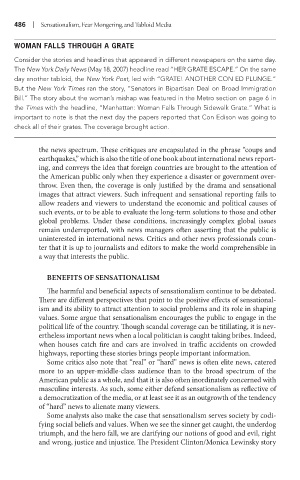Page 507 - Battleground The Media Volume 1 and 2
P. 507
| Sensat onal sm, Fear Monger ng, and Tablo d Med a
woMan Falls through a grate
Consider the stories and headlines that appeared in different newspapers on the same day.
The New York Daily News (May 18, 2007) headline read “HER GRATE ESCAPE.” On the same
day another tabloid, the New York Post, led with “GRATE! ANOTHER CON ED PLUNGE.”
But the New York Times ran the story, “Senators in Bipartisan Deal on Broad Immigration
Bill.” The story about the woman’s mishap was featured in the Metro section on page 6 in
the Times with the headline, “Manhattan: Woman Falls Through Sidewalk Grate.” What is
important to note is that the next day the papers reported that Con Edison was going to
check all of their grates. The coverage brought action.
the news spectrum. These critiques are encapsulated in the phrase “coups and
earthquakes,” which is also the title of one book about international news report-
ing, and conveys the idea that foreign countries are brought to the attention of
the American public only when they experience a disaster or government over-
throw. Even then, the coverage is only justified by the drama and sensational
images that attract viewers. Such infrequent and sensational reporting fails to
allow readers and viewers to understand the economic and political causes of
such events, or to be able to evaluate the long-term solutions to those and other
global problems. Under these conditions, increasingly complex global issues
remain underreported, with news managers often asserting that the public is
uninterested in international news. Critics and other news professionals coun-
ter that it is up to journalists and editors to make the world comprehensible in
a way that interests the public.
BEnEFiTs oF sEnsaTionaLism
The harmful and beneficial aspects of sensationalism continue to be debated.
There are different perspectives that point to the positive effects of sensational-
ism and its ability to attract attention to social problems and its role in shaping
values. Some argue that sensationalism encourages the public to engage in the
political life of the country. Though scandal coverage can be titillating, it is nev-
ertheless important news when a local politician is caught taking bribes. Indeed,
when houses catch fire and cars are involved in traffic accidents on crowded
highways, reporting these stories brings people important information.
Some critics also note that “real” or “hard” news is often elite news, catered
more to an upper-middle-class audience than to the broad spectrum of the
American public as a whole, and that it is also often inordinately concerned with
masculine interests. As such, some either defend sensationalism as reflective of
a democratization of the media, or at least see it as an outgrowth of the tendency
of “hard” news to alienate many viewers.
Some analysts also make the case that sensationalism serves society by codi-
fying social beliefs and values. When we see the sinner get caught, the underdog
triumph, and the hero fall, we are clarifying our notions of good and evil, right
and wrong, justice and injustice. The President Clinton/Monica Lewinsky story

